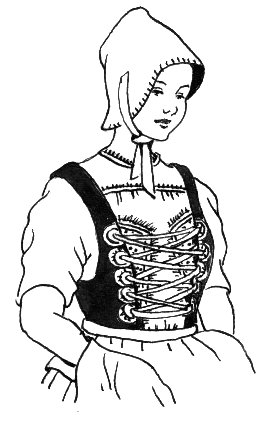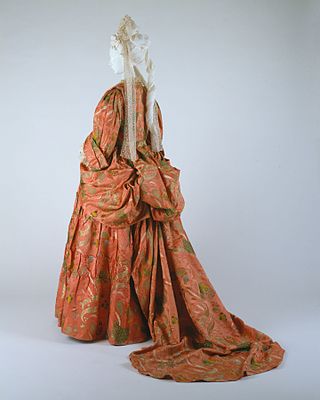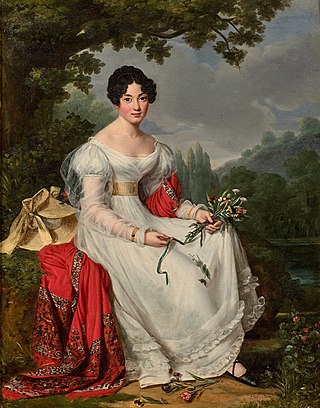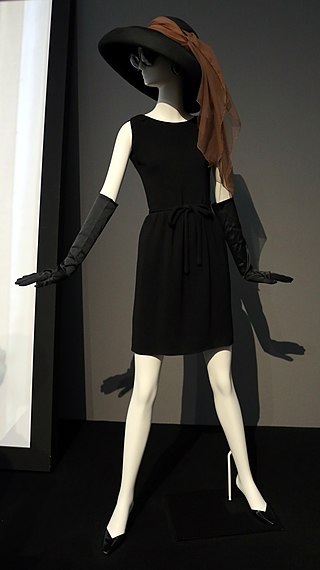
A blouse is a loose-fitting upper garment that may be worn by workmen, peasants, artists, women, and children. It is typically gathered at the waist or hips so that it hangs loosely ("blouses") over the wearer's body. Today, the word most commonly refers to a girl's or woman's dress shirt, although there is considerable confusion between a true blouse and a women's shirt. It can also refer to a man's shirt if it is a loose-fitting style, though it rarely is. Traditionally, the term has been used to refer to a shirt which blouses out or has an unmistakably feminine appearance, although even many "standard" shirts today have a somewhat blousy fit, and the numbers of men wearing such shirts may match that of women wearing actual blouses.

1830s fashion in Western and Western-influenced fashion is characterized by an emphasis on breadth, initially at the shoulder and later in the hips, in contrast to the narrower silhouettes that had predominated between 1800 and 1820.

A bodice is an article of clothing traditionally for women and girls, covering the torso from the neck to the waist. The term typically refers to a specific type of upper garment common in Europe during the 16th to the 18th century, or to the upper portion of a modern dress to distinguish it from the skirt and sleeves. The name bodice is etymologically an odd plural spelling of "body" and comes from an older garment called a pair of bodies.

A ball gown, ballgown or gown is a type of evening gown worn to a ball or a formal event. Most versions are cut off the shoulder with a low décolletage, exposed arms, and long bouffant styled skirts. Such gowns are typically worn with an opera-length white gloves and vintage jewelry or couture, stole, cape or cloak in lieu of a coat. Where "state decorations" are to be worn, they are on a bow pinned to the chest, and married women wear a tiara if they have one. Although synthetic fabrics are now sometimes used, the most common fabrics are satin, silk, taffeta and velvet with trimmings of lace, pearls, sequins, embroidery, ruffles, ribbons, rosettes and ruching.

An evening gown, evening dress or gown is a long dress usually worn at formal occasions. The drop ranges from ballerina, tea, to full-length. Such gowns are typically worn with evening gloves. Evening gowns are usually made of luxurious fabrics such as chiffon, velvet, satin, organza, etc. Silk is a popular fibre for many evening gowns. Although the terms are used interchangeably, ball gowns and evening gowns differ in that a ball gown will always have a full skirt and a fitted bodice, while an evening gown can be any silhouette—sheath, mermaid, fit and flare, A-line, or trumpet-shaped—and may have straps, halters or even sleeves.

A mantua is an article of women's clothing worn in the late 17th century and 18th century. Initially a loose gown, the later mantua was an overgown or robe typically worn over stays, stomacher and either a co-ordinating or contrasting petticoat.

Fashion in the period 1550–1600 in Western European clothing was characterized by increased opulence. Contrasting fabrics, slashes, embroidery, applied trims, and other forms of surface ornamentation remained prominent. The wide silhouette, conical for women with breadth at the hips and broadly square for men with width at the shoulders had reached its peak in the 1530s, and by mid-century a tall, narrow line with a V-lined waist was back in fashion. Sleeves and women's skirts then began to widen again, with emphasis at the shoulder that would continue into the next century. The characteristic garment of the period was the ruff, which began as a modest ruffle attached to the neckband of a shirt or smock and grew into a separate garment of fine linen, trimmed with lace, cutwork or embroidery, and shaped into crisp, precise folds with starch and heated irons.

Fashion in the years 1750–1775 in European countries and the colonial Americas was characterised by greater abundance, elaboration and intricacy in clothing designs, loved by the Rococo artistic trends of the period. The French and English styles of fashion were very different from one another. French style was defined by elaborate court dress, colourful and rich in decoration, worn by such iconic fashion figures as Marie Antoinette.

During the 1820s in European and European-influenced countries, fashionable women's clothing styles transitioned away from the classically influenced "Empire"/"Regency" styles of c. 1795–1820 and re-adopted elements that had been characteristic of most of the 18th century, such as full skirts and clearly visible corseting of the natural waist.

A gown, from the Saxon word, gunna, is a usually loose outer garment from knee-to-full-length worn by men and women in Europe from the Early Middle Ages to the 17th century, and continuing today in certain professions; later, the term gown was applied to any full-length woman's garment consisting of a bodice and an attached skirt. A long, loosely fitted gown called a Banyan was worn by men in the 18th century as an informal coat.

Fashion in the period 1700–1750 in European and European-influenced countries is characterized by a widening silhouette for both men and women following the tall, narrow look of the 1680s and 90s. This era is defined as late Baroque/Rococo style. The new fashion trends introduced during this era had a greater impact on society, affecting not only royalty and aristocrats, but also middle and even lower classes. Clothing during this time can be characterized by soft pastels, light, airy, and asymmetrical designs, and playful styles. Wigs remained essential for men and women of substance, and were often white; natural hair was powdered to achieve the fashionable look. The costume of the eighteenth century, if lacking in the refinement and grace of earlier times, was distinctly quaint and picturesque.

Fashion in the years following World War II is characterized by the resurgence of haute couture after the austerity of the war years. Square shoulders and short skirts were replaced by the soft femininity of Christian Dior's "New Look" silhouette, with its sweeping longer skirts, fitted waist, and rounded shoulders, which in turn gave way to an unfitted, structural look in the later 1950s.

A kirtle is a garment that was worn by men and women in the Middle Ages. It eventually became a one-piece garment worn by women from the late Middle Ages into the Baroque period. The kirtle was typically worn over a chemise or smock, which acted as a slip, and under the formal outer garment, a gown or surcoat.

A dress is a garment traditionally worn by women or girls consisting of a skirt with an attached bodice. It consists of a top piece that covers the torso and hangs down over the legs. A dress can be any one-piece garment containing a skirt of any length, and can be formal or casual.

Twelfth century European fashion was simple and differed only in details from the clothing of the preceding centuries. Men wore knee-length tunics for most activities, and men of the upper classes wore long tunics, with hose and mantle or cloaks. Women wore long tunics or gowns. A close fit to the body, full skirts, and long flaring sleeves were characteristic of upper-class fashion for both men and women.

Ancient Egyptian clothes refers to clothing worn in ancient Egypt from the end of the Neolithic period to the collapse of the Ptolemaic Kingdom with the death of Cleopatra in 30 BC. Egyptian clothing was filled with a variety of colors. Adorned with precious gems and jewels, the fashions of the ancient Egyptians were made for not only beauty but also comfort. Egyptian fashion was created to keep cool while in the hot desert.

Audrey Hepburn wore a "little black dress" in the 1961 romantic comedy film Breakfast at Tiffany's. The garment was designed by Hubert de Givenchy, and is worn during the opening scene of the film. The dress is referred to as one of the most iconic clothing items in the history of the twentieth century, and perhaps the most famous little black dress of all time.

Fashion in the twenty years between 1775 and 1795 in Western culture became simpler and less elaborate. These changes were a result of emerging modern ideals of selfhood, the declining fashionability of highly elaborate Rococo styles, and the widespread embrace of the rationalistic or "classical" ideals of Enlightenment philosophes.

An overskirt is a type of women's short skirt which is draped over another garment, such as a skirt, breeches, or trousers. Although peplum is often used as another term for overskirt, it should not be confused with the peplos or "peplum dress", which was worn in ancient Greece.

The fashion of actress Audrey Hepburn, both on and off-screen, has impacted trends and pop culture, and she is considered a style icon.

























